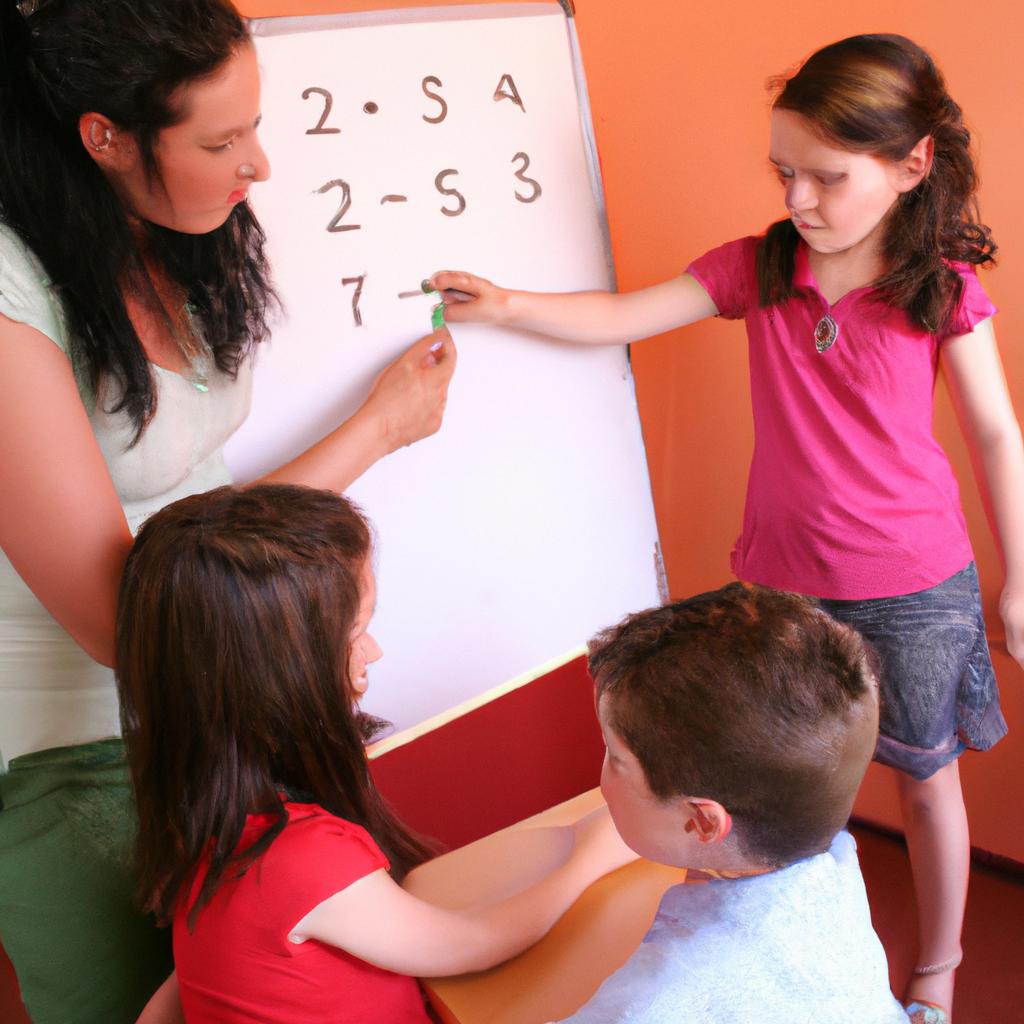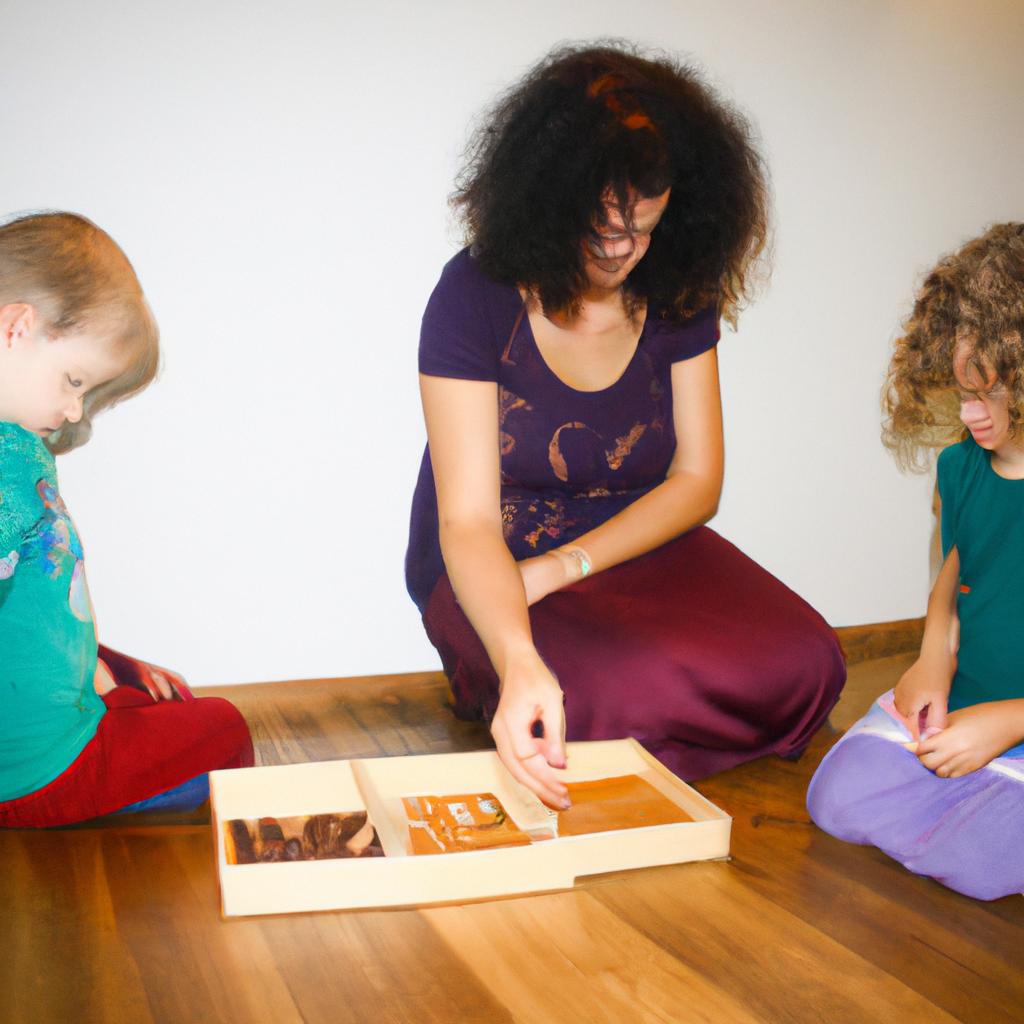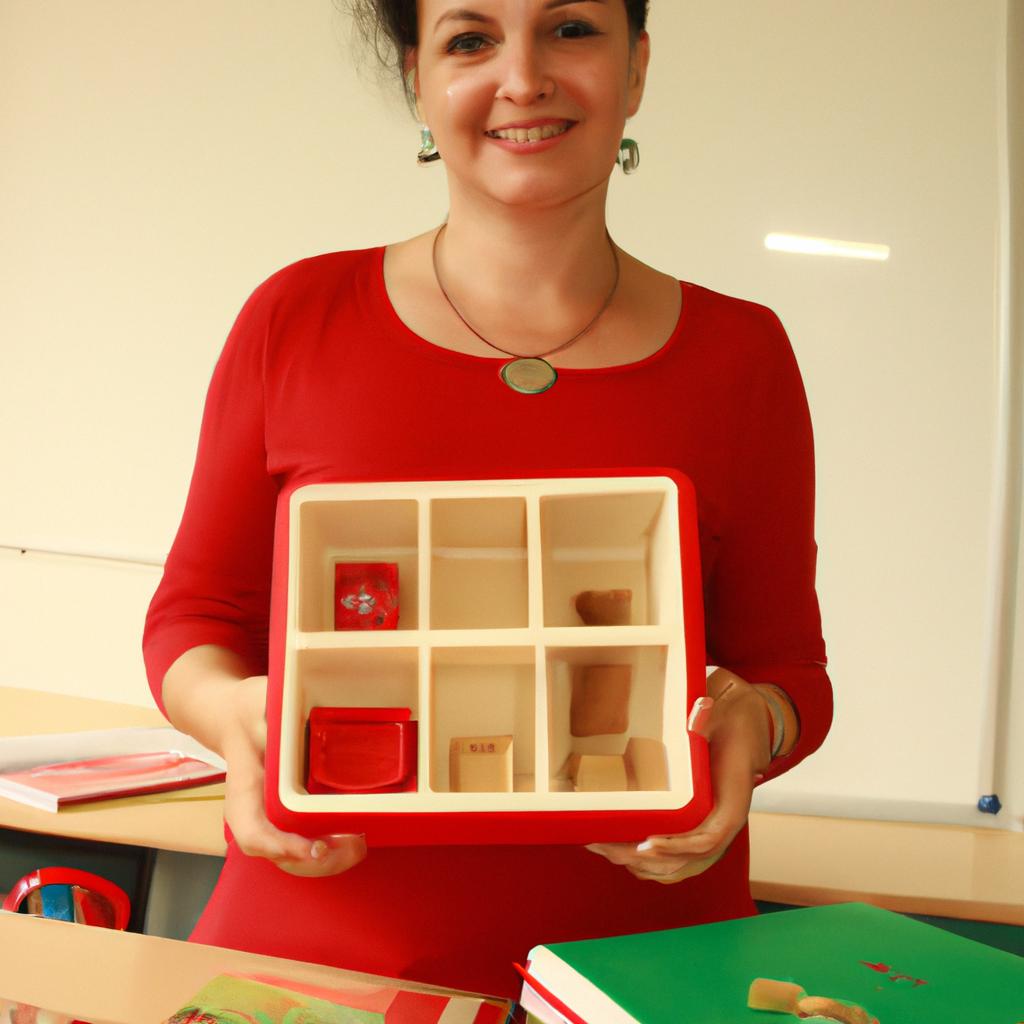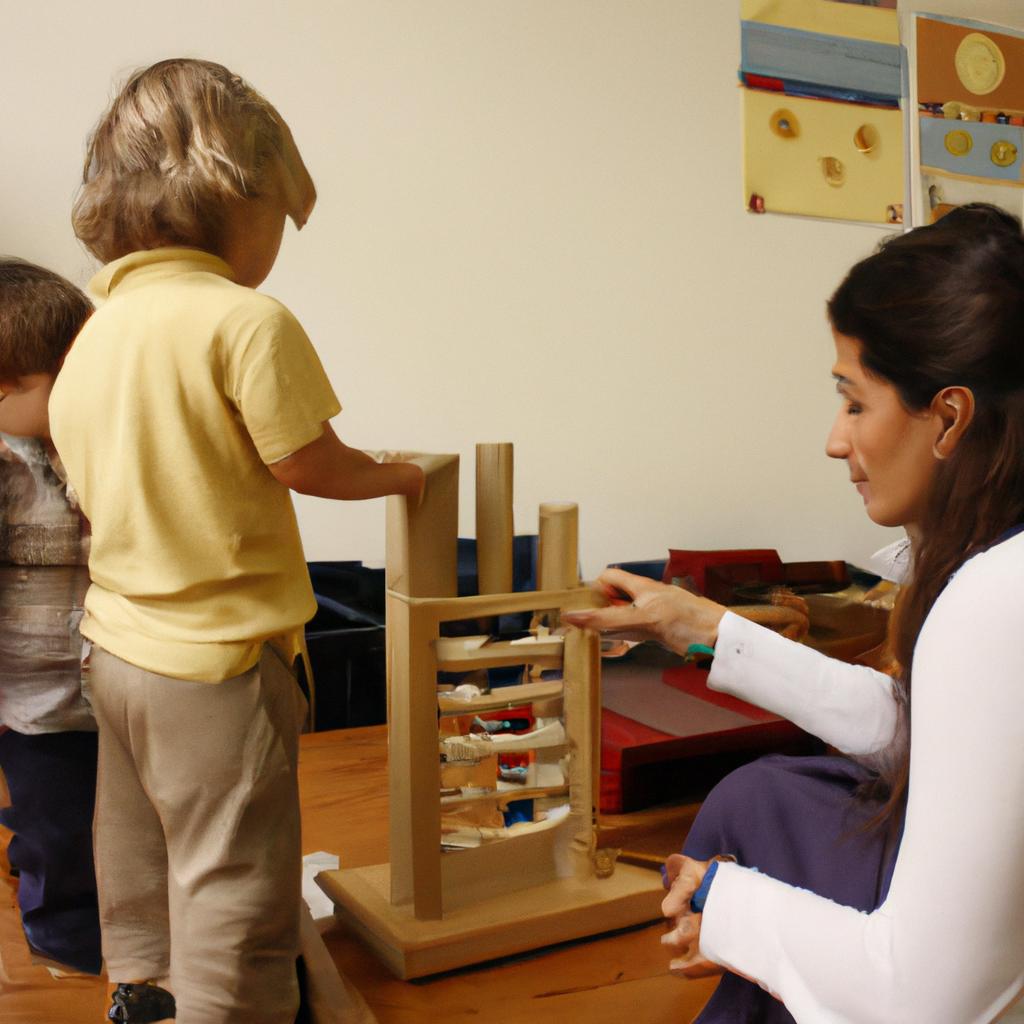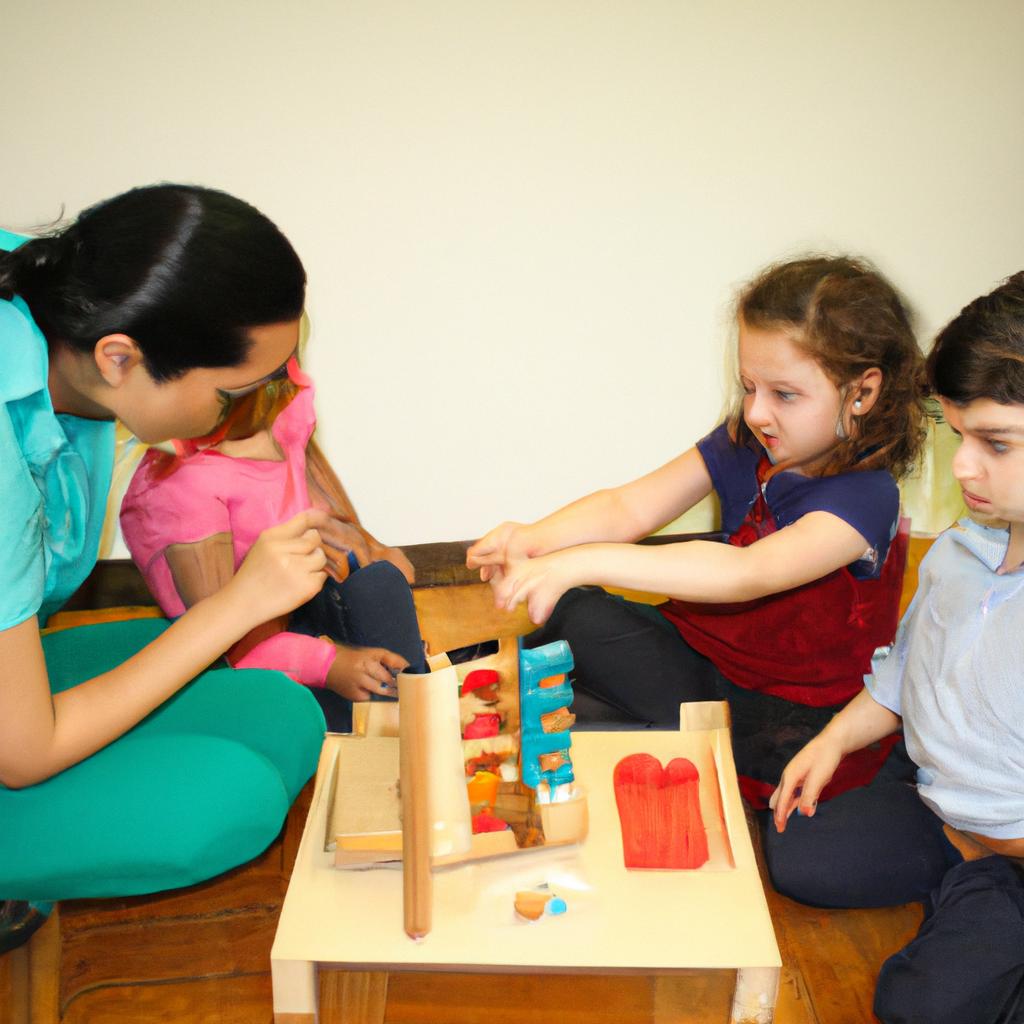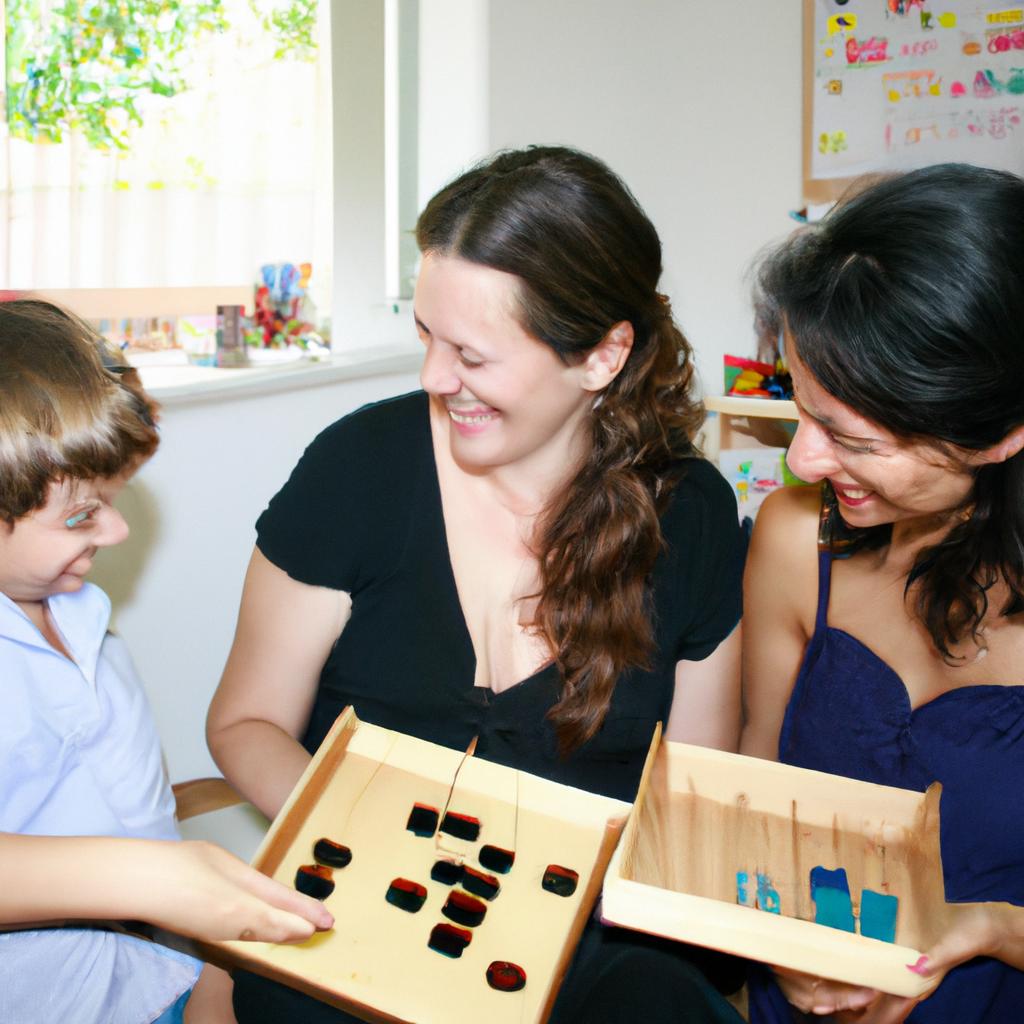In recent years, the Montessori method of education has gained significant attention for its unique approach to teaching and learning. With a focus on individualized instruction and hands-on materials, Montessori schools provide an alternative to traditional educational models. This article aims to explore one specific aspect of the Montessori curriculum: mathematics materials and curriculum. By delving into the principles behind these materials and their role in fostering mathematical understanding, this guide will equip educators and parents with valuable insights into how mathematics is taught in Montessori schools.
Imagine a classroom where students are not simply memorizing multiplication tables or solving equations mechanically, but instead engaging with math concepts through tangible manipulatives. In such a setting, children have the opportunity to develop a deep understanding of fundamental mathematical principles at their own pace. This is precisely what the Montessori approach offers when it comes to mathematics education. The carefully designed materials used in Montessori classrooms aim to cultivate conceptual understanding, problem-solving skills, and critical thinking abilities among young learners. Through real-life examples and practical applications, students grasp abstract mathematical ideas by building upon concrete experiences – an experiential learning process that sets them up for success in higher-level mathematics throughout their academic journey.
At the core of the Montessor i curriculum in mathematics are the Montessori math materials. These materials are carefully sequenced and designed to facilitate the progression of learning from simple to complex mathematical concepts. They include a wide range of manipulatives such as number rods, bead bars, golden beads, spindle boxes, and more.
The Montessori math materials provide students with hands-on experiences that allow them to explore mathematical concepts concretely. For example, the number rods help children understand quantity and length by visually representing numbers 1-10 using different colored rods. The bead bars introduce children to place value and addition by representing numbers using beads on a wire.
By manipulating these materials, students can physically see and feel mathematical concepts, which helps them develop a strong foundation of understanding. The emphasis on concrete learning before moving into abstract concepts ensures that students truly grasp the underlying principles of mathematics.
In addition to the materials themselves, the Montessori math curriculum is also structured in a way that allows for individualized instruction. Students progress through the curriculum at their own pace, with teachers providing guidance and support as needed. This approach recognizes that each child learns differently and allows for personalized learning experiences tailored to their unique needs and abilities.
Overall, the Montessori method of teaching mathematics through hands-on materials fosters a deep understanding of mathematical concepts and promotes critical thinking skills. By engaging students actively in their learning process, this approach sets them up for success not only in math but also in developing problem-solving skills that can be applied across various subjects and real-life situations.
The Philosophy Behind Montessori Education
Imagine a classroom where students are actively engaged in their learning, exploring materials at their own pace and collaborating with classmates. This is the essence of Montessori education, an approach developed by Dr. Maria Montessori over a century ago. At its core, Montessori philosophy emphasizes independence, freedom within limits, and respect for each child’s unique development.
Central to the Montessori method is the belief that children learn best through hands-on experiences. By providing carefully designed materials and creating an environment that fosters curiosity and exploration, educators empower students to take charge of their own learning journey. For example, in a Montessori math class, you may find children using colorful beads to understand abstract concepts like addition or multiplication.
To fully grasp the impact of Montessori education, consider these key points:
- Individualized Learning: In a traditional classroom setting, teachers often deliver standardized lessons to large groups of students. Conversely, in a Montessori school, instruction is tailored to meet individual needs and interests.
- Intrinsic Motivation: Rather than relying on external rewards or punishments, the Montessori approach encourages intrinsic motivation by allowing children to determine their own goals and pace of learning.
- Holistic Development: Beyond academic achievement, Montessori education focuses on nurturing all aspects of a child’s development – cognitive, social-emotional, physical, and moral.
- Community Engagement: Collaboration and cooperation are highly valued in the Montessori classroom. Students work together across age groups and contribute to the well-being of their community.
| Benefit | Description | Example |
|---|---|---|
| Enhanced problem-solving skills | Through self-directed activities and inquiry-based learning, students develop critical thinking abilities. | A group of elementary students working together to design an innovative solution for reducing plastic waste in their local community. |
| Increased sense of responsibility | By giving students freedom and trust, Montessori education fosters a strong sense of personal responsibility. | A primary student taking ownership of maintaining the classroom plants by watering them regularly and observing their growth. |
| Cultivation of self-discipline | The emphasis on choice and autonomy enables children to develop self-discipline as they follow their interests and complete tasks independently. | A toddler carefully returning materials to their proper place after using them in order to maintain an organized environment. |
As we delve further into this guide, it becomes evident that mathematics plays a crucial role in the Montessori curriculum. By understanding how mathematics is integrated throughout various aspects of learning, we can appreciate its significance in fostering key developmental skills for young learners.
Transitioning seamlessly from discussing the philosophy behind Montessori education, let us now explore the pivotal role that mathematics plays within this unique curriculum.
The Role of Mathematics in Montessori Curriculum
The Philosophy Behind Montessori Education emphasizes the importance of providing children with an environment that fosters independence, self-directed learning, and hands-on experiences. In line with this philosophy, Mathematics plays a crucial role in the Montessori curriculum as it provides students with opportunities to develop logical thinking skills, problem-solving abilities, and a solid foundation in numeracy.
Consider the case study of Sarah, a five-year-old student at a Montessori school. In her mathematics lessons, Sarah engages in various activities such as counting objects, working with manipulatives like number rods and beads, and exploring mathematical concepts through games. These hands-on experiences allow her to understand abstract mathematical ideas concretely and intuitively.
To facilitate effective teaching and learning of mathematics in Montessori schools, educators utilize a range of materials and approaches. Here are some key aspects:
-
Montessori Math Materials: The use of specially designed materials is integral to the Montessori approach. These materials are carefully sequenced and provide students with concrete representations of mathematical concepts. For example:
- Number Rods: Wooden rods representing quantities from one to ten help children grasp the concept of quantity.
- Golden Beads: Small golden beads represent units (ones), tens, hundreds, and thousands. Students can physically manipulate these beads to build numbers and perform addition or subtraction operations.
- Spindle Boxes: This material helps children understand place value by separating different quantities into compartments based on their numerical values.
Incorporating emotional elements within the section will engage readers more effectively:
- Highlighting how these materials create engaging learning experiences for children
- Stressing how practical applications of math foster real-world connections
- Emphasizing how empowering it is for young learners to discover mathematical concepts independently
Furthermore, incorporating a table showcasing specific examples or benefits of each material could evoke an emotional response regarding their effectiveness in promoting conceptual understanding.
As we delve further into the Principles of Montessori Mathematics Materials, we will explore how these materials align with the overall goals and objectives of a Montessori education. By understanding the guiding principles behind the development and use of mathematics materials, educators can create an environment that nurtures children’s mathematical abilities while fostering their love for learning.
Principles of Montessori Mathematics Materials
In the previous section, we explored the significance of mathematics within the Montessori curriculum. Now, let us delve deeper into the principles underlying Montessori mathematics materials and their role in fostering a love for numbers and problem-solving skills among students.
To illustrate these principles, imagine a hypothetical scenario where a child named Emma is introduced to the Montessori math materials. Emma starts her journey with the Number Rods material, which consists of ten rods varying in length from 10 centimeters to one meter. Through hands-on exploration with this material, Emma not only develops an understanding of quantity but also gains a sense of order and sequence.
One key principle that guides the development and selection of Montessori mathematics materials is their ability to evoke emotional engagement. The use of concrete manipulatives like beads or blocks allows children to physically manipulate quantities, leading to a deep understanding of mathematical concepts. This tangible experience fosters excitement and curiosity, igniting an emotional connection between the learner and mathematics.
Let us now explore four essential characteristics that define Montessori mathematics materials:
- Sensorial: The materials engage multiple senses such as touch, sight, and hearing, enabling children to grasp abstract mathematical concepts through direct sensory experiences.
- Self-correcting: Each material provides instant feedback on correctness without requiring adult intervention. This aspect encourages independent learning and builds confidence.
- Isolation of difficulty: Materials are designed to isolate specific mathematical concepts at various levels of complexity. This approach ensures gradual progression in learning while allowing each child to work at their own pace.
- Integration across disciplines: Many math materials interconnect with other areas such as language or geometry, promoting holistic learning experiences that strengthen comprehension.
Additionally, incorporating table formats can further enhance student engagement by presenting information clearly and concisely. Consider the following example table showcasing different Montessori math materials alongside their benefits:
| Math Material | Benefits |
|---|---|
| Bead Stair | Reinforces counting and introduces skip counting. |
| Golden Beads | Develops an understanding of place value and arithmetic operations. |
| Stamp Game | Promotes regrouping, addition, subtraction, and multiplication skills. |
| Fraction Circles | Encourages exploration of fraction concepts through visual representation. |
In conclusion, Montessori mathematics materials play a vital role in shaping children’s mathematical understanding by providing hands-on experiences that engage their senses and emotions. By incorporating principles such as sensory engagement, self-correction, isolation of difficulty, and integration across disciplines, these materials facilitate meaningful learning experiences for young learners.
Transition into the subsequent section about “Sequential Learning: Montessori Math Curriculum”:
Moving forward from this foundation, we now shift our focus to the sequential learning approach employed within the Montessori math curriculum.
Sequential Learning: Montessori Math Curriculum
Montessori mathematics materials are carefully designed to facilitate the learning process and align with the principles of Montessori education. These materials provide students with concrete, hands-on experiences that lay a strong foundation for understanding abstract mathematical concepts. One example is the use of golden beads in teaching place value. By physically manipulating these beads, children can grasp the concept of tens, hundreds, thousands, and beyond.
The Montessori math curriculum follows a sequential approach that allows students to progress at their own pace while building upon previously acquired knowledge. This approach ensures that students have a solid understanding of fundamental concepts before moving on to more complex topics. The curriculum covers various aspects of mathematics, including numeracy, geometry, measurement, and problem-solving skills.
One important feature of Montessori mathematics materials is their emphasis on sensorial exploration and manipulation. This tactile engagement helps children develop not only mathematical skills but also fine motor skills and hand-eye coordination. Furthermore, the materials encourage independent thinking and problem-solving as students explore different ways to solve mathematical problems.
- Increased confidence in mathematical abilities
- Joyful learning through hands-on activities
- Sense of accomplishment when mastering new concepts
- Development of critical thinking skills
| Benefits | Emotional Response |
|---|---|
| Increased | Confidence in |
| Mathematical Abilities | |
| Joyful | Learning Through |
| Hands-on Activities | |
| Sense | Of Accomplishment When |
| Mastering New Concepts |
In summary, Montessori mathematics materials adhere to specific principles that enable effective learning experiences for students. Through hands-on exploration and a sequential curriculum, children can acquire essential math skills while developing other cognitive abilities simultaneously. The next section will delve into the numerous benefits of Montessori math education by highlighting its impact on children’s overall educational journey.
Benefits of Montessori Math Education
In the previous section, we discussed the importance of sequential learning in the Montessori math curriculum. Now, let’s delve deeper into how this approach is implemented and its impact on students’ mathematical development.
To illustrate the effectiveness of sequential learning, consider a hypothetical scenario where a student named Emily enters a Montessori school at age five with limited exposure to mathematics. Through carefully designed materials and activities, Emily gradually progresses from basic number recognition to more complex concepts like addition and subtraction. By following a structured sequence of lessons, she acquires a solid foundation in math that prepares her for future challenges.
The success of sequential learning lies in its systematic progression that allows children to build upon previously learned skills. Here are some key aspects of this approach:
- Concrete Materials: The use of manipulative materials enables hands-on exploration and understanding of abstract mathematical ideas.
- Self-Paced Learning: Students work at their own pace, allowing them to fully grasp each concept before moving on to the next level.
- Individualized Instruction: Teachers observe students closely and provide personalized guidance based on their unique needs and abilities.
- Mastery-Based Assessment: Instead of traditional grades or tests, mastery-based assessment focuses on individual progress and ensures thorough comprehension before advancing.
- Increased confidence as children master new mathematical concepts
- Sense of accomplishment when progressing through sequential levels
- Joyful engagement during interactive hands-on activities
- Nurturing a lifelong love for mathematics through positive experiences
| Advantages | Challenges | Solutions |
|---|---|---|
| Builds deep conceptual understanding | Requires trained Montessori teachers | Invest in professional development programs |
| Promotes critical thinking skills | Limited availability in mainstream schools | Advocate for integration into existing curricula |
| Fosters independence and self-motivation | Initial investment in specialized materials | Seek community support or grants |
| Encourages collaboration and peer learning | Potential resistance from traditional education systems | Demonstrate positive outcomes through research and case studies |
In conclusion, the Montessori math curriculum’s emphasis on sequential learning provides a solid foundation for students’ mathematical development. Through carefully designed materials, individualized instruction, and self-paced learning, children can progress at their own pace while building deep conceptual understanding. This approach not only cultivates mathematical skills but also fosters emotional engagement, confidence, and a lifelong love for mathematics.
Implementing Montessori Math Curriculum in the Classroom requires careful planning and consideration of various factors to create an optimal environment for student growth and success.
Implementing Montessori Math Curriculum in the Classroom
Having discussed the numerous benefits of Montessori math education, it is crucial to understand how these principles are implemented in a classroom setting.
In a Montessori classroom, the implementation of the math curriculum revolves around creating an environment that fosters exploration and independent learning. For instance, let’s consider a hypothetical scenario where a student named Sarah is introduced to addition using Montessori materials. Sarah is provided with concrete objects such as colored beads or rods that represent numerical values. Through hands-on activities and guided practice, she can visually and experientially grasp the concept of adding numbers together. This approach allows students like Sarah to develop a deep understanding of mathematical operations by engaging their senses and actively participating in their own learning process.
To effectively implement the Montessori math curriculum, educators follow several key strategies:
-
Individualized Learning: The Montessori method recognizes that each child learns at their own pace. Teachers provide personalized instruction tailored to meet individual needs, ensuring students receive appropriate challenges while feeling supported.
-
Multi-age Groupings: In a Montessori classroom, children across different age groups work together. Younger students observe and learn from older peers, fostering collaboration and reinforcing concepts through peer teaching.
-
Prepared Environment: The classroom is thoughtfully arranged with various manipulative materials easily accessible to students. These materials help facilitate self-directed learning experiences while promoting concentration and problem-solving skills.
-
Integration of Concepts: Rather than compartmentalizing mathematics into separate topics (such as arithmetic or geometry), the Montessori approach emphasizes interconnectedness between different areas of mathematics. Students explore relationships among mathematical concepts holistically, enhancing their overall understanding.
| Strategies for Implementing Montessori Math Curriculum |
|---|
| 1 |
| 2 |
| 3 |
| 4 |
This approach creates an engaging and interactive learning environment that fosters a love for mathematics. By allowing students to take ownership of their education, the Montessori math curriculum nurtures not only mathematical skills but also critical thinking, problem-solving abilities, and self-confidence.
Overall, the implementation of the Montessori math curriculum in classrooms offers students an enriching educational experience. Through hands-on activities, personalized instruction, and integration of concepts, this approach empowers children to become active learners who develop a deep understanding and appreciation for mathematics.

